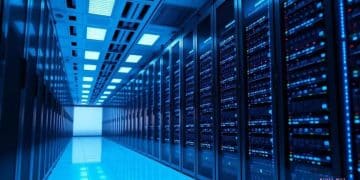Hybrid computing systems adoption: transforming your approach

Hybrid computing systems adoption combines on-premises infrastructure with cloud resources, enhancing scalability, cost efficiency, and flexibility while addressing challenges like data security and integration complexities.
Hybrid computing systems adoption is becoming increasingly vital in today’s tech landscape. But have you considered what it means for your business? Let’s dive into this intriguing topic.
Understanding hybrid computing systems
Understanding hybrid computing systems is vital as businesses evolve in today’s tech landscape. These systems combine traditional on-premises computing with cloud resources, offering flexibility and scalability.
In essence, hybrid computing allows organizations to manage their data and applications across both local and cloud environments. This integration helps companies optimize their resources and costs while maintaining control over critical operations.
Key components of hybrid computing
Hybrid computing systems consist of various interconnected components. Understanding these is crucial for effective implementation:
- On-premises infrastructure: Includes local servers and storage, providing control over sensitive data.
- Cloud services: Enables elastic resources for computing, storage, and applications.
- Networking: Ensures seamless communication between on-premises and cloud resources.
- Management tools: Software solutions that help monitor and manage both environments efficiently.
These components must work together for hybrid systems to be effective. This interconnectivity offers the benefits of both worlds, ensuring businesses can adapt quickly to changing demands.
Moreover, hybrid computing helps organizations enhance their performance while minimizing downtime. A key advantage is the ability to run workloads in the most suitable environment: sensitive information can remain on-premises, while less critical tasks can operate in the cloud.
The role of virtualization
Virtualization is another vital aspect that enables hybrid computing systems. By creating virtual instances of servers and storage, organizations can maximize their infrastructure utilization. This efficiency leads to cost savings and better performance.
Cloud bursting is a strategy often employed in hybrid environments. It refers to the ability to utilize cloud resources during peak usage times, ensuring that businesses always have the capacity to meet demand. This flexible approach allows companies to scale without heavy upfront investments.
Ultimately, understanding these systems and their components equips businesses to adopt the technology beneficially, ensuring they stay competitive in their industries.
Benefits of adopting hybrid computing systems
Adopting hybrid computing systems offers numerous advantages that can significantly enhance an organization’s efficiency and flexibility. Many businesses are turning to this model as it combines the strengths of both on-premises and cloud computing.
One major benefit is improved scalability. Businesses can easily scale their resources to meet fluctuating demands, ensuring that they only pay for what they use. This is particularly valuable during peak times when workloads may surge.
Cost-effectiveness
Another key advantage is cost savings. By leveraging cloud resources, organizations can reduce their investments in hardware and maintenance. Hybrid setups often lead to lower overall IT expenses.
- Reduced capital expenditures: By utilizing cloud services, companies can minimize upfront costs for hardware.
- Pay-as-you-go models: The flexibility of only paying for required resources leads to better budget management.
- Optimized resource allocation: Businesses can allocate their computing resources more effectively, ensuring they meet demand without wasting money.
Furthermore, adopting hybrid computing systems enhances business continuity. With data and applications spread across different environments, organizations can more effectively mitigate risks associated with downtimes.
For instance, if an on-premises server fails, workloads can continue running in the cloud, allowing operations to remain uninterrupted. This dual approach not only increases reliability but also builds a more resilient infrastructure.
Increased flexibility and control
Another important aspect is the increased flexibility that hybrid systems provide. Organizations can choose which data to store on-premises and which to migrate to the cloud. This capability gives businesses more control over their sensitive information.
Moreover, hybrid computing enables easier integration with existing technologies. Companies can gradually transition to a hybrid model without overhauling their entire IT structure, ensuring a smoother adoption process.
In summary, the benefits of adopting hybrid computing systems are clear. From cost savings and improved scalability to better flexibility and control, organizations stand to gain by embracing this innovative approach.
Key challenges in hybrid computing adoption
While adopting hybrid computing systems can bring many benefits, there are also several key challenges organizations might face. Understanding these challenges can help businesses prepare and strategize their implementation effectively.
One significant challenge is managing the integration between on-premises and cloud environments. This integration requires specialized skills and tools to ensure seamless communication and data flow. Organizations may need to invest time and resources into training their staff or hiring experts who understand both environments.
Data security and compliance
Another major concern is data security. With data spread across different locations, maintaining security standards can be daunting. Businesses need to ensure that sensitive information is adequately protected, especially when using third-party cloud services.
- Identity and access management: Establishing strict access controls is crucial to protect data.
- Encryption: Utilizing strong encryption methods helps secure data during transfer and storage.
- Compliance: Companies must adhere to relevant regulations and standards, which can differ drastically across regions.
Moreover, organizations may experience difficulties in managing costs effectively. While hybrid systems can be cost-efficient, improper resource allocation or unexpected usage can lead to higher expenses. Monitoring usage and optimizing resources is essential to avoid overspending.
Another hurdle is the potential operational complexity that comes with maintaining two distinct environments. Organizations must ensure that operations run smoothly across both cloud and on-premises systems. This complexity can lead to increased chances of downtime or errors if not managed correctly.
Vendor lock-in challenges
Additionally, businesses may encounter vendor lock-in issues when relying too heavily on a particular cloud service provider. Switching providers or moving data back to on-premises systems can be complicated and costly.
Hence, it is vital for companies to plan their hybrid strategy carefully. This includes evaluating multiple providers and considering the implications of long-term partnerships.
In summary, addressing these challenges in hybrid computing adoption is crucial for successful implementation. By being aware of potential issues, organizations can navigate the complexities and create a robust hybrid environment that meets their needs.
Best practices for implementing hybrid systems
Implementing hybrid systems effectively requires careful planning and execution. By following best practices, organizations can maximize their benefits while minimizing potential pitfalls.
One crucial step is to evaluate current infrastructure and business needs thoroughly. Understanding what your organization requires can help tailor the hybrid system to fit those needs precisely. This evaluation should include assessing both on-premises capabilities and available cloud resources.
Choosing the right cloud provider
Choosing the right cloud provider is essential. Not all providers offer the same features or levels of support. Organizations should look for providers that align well with their specific requirements, including security measures and compliance standards.
- Evaluate service levels: Make sure the cloud provider meets your performance needs.
- Consider support options: Choose a provider that offers robust customer support.
- Check scalability: Ensure the provider can grow with your business.
Moreover, it’s important to establish clear governance and compliance policies. This helps to maintain control over your data while ensuring that all operations adhere to relevant regulations.
Training and skill development
Investing in training for your IT staff is another best practice. The success of hybrid systems often depends on the skills of the personnel managing them. Providing ongoing training programs can help ensure your team is equipped to handle both cloud and on-premises environments effectively.
Additionally, create a detailed migration plan that outlines the steps necessary to transition to a hybrid environment. This plan should include timelines, resources required, and contingency plans for potential challenges.
Regularly monitoring the hybrid system is vital for identifying issues before they escalate. Employing monitoring tools will help track performance and alert you to potential problems, allowing for proactive management.
Finally, maintain open communication lines among teams. Ensuring that everyone is on the same page helps to avoid misunderstandings and fosters collaboration between cloud and on-premises teams. By following these best practices, your organization can successfully implement a hybrid computing solution that supports its goals.
Future trends in hybrid computing technology
The future trends in hybrid computing technology promise to reshape how organizations leverage their IT resources. As businesses seek to enhance performance and efficiency, several developments are emerging in this space.
One significant trend is the increasing adoption of artificial intelligence (AI) and machine learning in hybrid systems. These technologies can help automate processes and optimize workloads, allowing organizations to make better use of their hybrid environments. By analyzing data in real-time, AI can identify patterns that help improve efficiency.
Advancements in cloud services
Moreover, cloud service providers are continuously innovating. They offer more advanced features, making it easier for companies to integrate their on-premises systems with cloud solutions. Features like serverless computing and ultra-fast data transfers will become standard, providing seamless interactions between environments.
- Multi-cloud strategies: Businesses will increasingly utilize multi-cloud approaches, allowing them to select the best services from various providers.
- Improved security features: Enhanced security measures will be integrated into hybrid solutions, ensuring data protection across multiple platforms.
- Greater personalization: Cloud services will become more adaptable, allowing businesses to customize solutions tailored to their specific needs.
Another trend is the growing emphasis on edge computing. This approach involves processing data closer to where it is generated, which can reduce latency and improve response times. By combining edge computing with hybrid systems, organizations can enhance performance for applications requiring real-time processing.
Furthermore, the demand for sustainability is influencing hybrid computing. Companies are increasingly focused on reducing their carbon footprint. This trend will lead to more energy-efficient solutions and environmentally friendly practices within hybrid infrastructures.
Integration of Internet of Things (IoT)
The integration of the Internet of Things (IoT) is also set to expand. As more devices are connected, the volume of data generated will rise, necessitating robust hybrid solutions to manage and analyze this data effectively. Organizations that can harness IoT insights will gain significant competitive advantages.
Ultimately, tracking these trends is vital for businesses keen on maximizing their hybrid computing capabilities. Staying informed allows companies to adapt to changes and capitalize on new opportunities.
FAQ – Frequently Asked Questions about Hybrid Computing Systems
What are hybrid computing systems?
Hybrid computing systems combine on-premises infrastructure with cloud resources, allowing organizations to keep sensitive data local while utilizing cloud scalability.
What are the benefits of adopting hybrid computing systems?
Benefits include improved scalability, cost efficiency, enhanced flexibility, and better business continuity.
What challenges might I face when adopting hybrid systems?
Challenges include managing integration between environments, ensuring data security, and potential vendor lock-in issues.
How can I ensure a successful implementation of hybrid systems?
To ensure success, evaluate your current infrastructure, choose the right cloud provider, invest in staff training, and establish clear governance policies.
What future trends should I be aware of in hybrid computing?
Key trends include the integration of AI, advancements in cloud services, the rise of edge computing, and an emphasis on sustainability.





